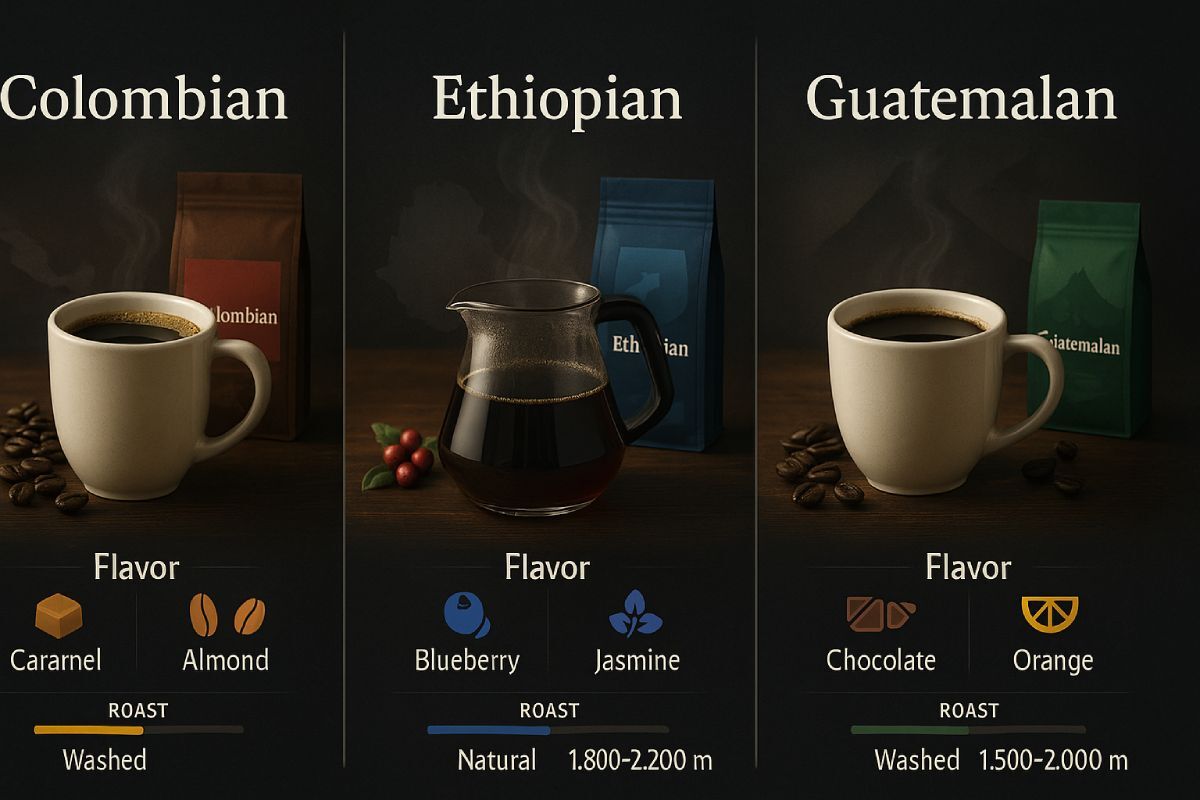Quick take: Most specialty coffee is Arabica (Coffea arabica), but origin, altitude, variety, processing, and roast level create distinct flavors. If you want balanced and familiar, choose Colombian. For fruity and floral complexity, go Ethiopian. Prefer chocolatey with gentle fruit? Try Guatemalan. For smooth, nutty, lower-acidity cups, consider Brazilian or Mexican. Even when coffees are all Arabica, where and how they’re grown and processed can change the cup dramatically: Flavor: Caramel, red apple, milk chocolate, gentle florals. Acidity: Medium. Body: Medium. Colombian coffees are celebrated for crowd-pleasing balance and a smooth, sweet finish—great for everyday drinking and blends. Best roast levels: Light-to-medium to showcase sweetness; medium-dark for richer chocolate. Brew pairings: Drip machines, pour-over (V60/Kalita), AeroPress; medium grinds shine here. Flavor: Jasmine, bergamot, lemon, stone fruit and berries (especially in natural-processed lots). Acidity: Medium-high. Body: Light-to-medium. Ethiopia offers some of the world’s most aromatic and complex cups. Washed coffees lean bright and tea-like; natural coffees can be intensely fruity. Best roast levels: Light-to-light-medium to preserve aromatics. Brew pairings: Pour-over, Chemex, cupping; for espresso, expect a lively, fruit-forward shot. Flavor: Cocoa, brown sugar, citrus or stone fruit depending on region (e.g., Antigua, Huehuetenango). Acidity: Medium. Body: Medium-to-full. Guatemalan beans often pair round sweetness with structured acidity, making them versatile for both filter and espresso. Best roast levels: Light-medium to medium to emphasize chocolate and balance. Brew pairings: Drip, French press, espresso. Flavor: Milk/dark chocolate, toasted nuts, subtle dried fruit. Acidity: Lower. Body: Medium-to-full. These origins excel in approachable, chocolate-forward profiles. They make excellent base components in espresso blends and are great for drinkers who prefer smooth, less-tangy cups. Best roast levels: Medium to medium-dark for sweetness and body. Brew pairings: Espresso, moka pot, drip. Heads-up: Flavor varies by micro-region, variety, processing, season, and roaster. Use this table as a starting point. Shop Single-Origin Coffee Explore Colombian Explore Ethiopian Explore Guatemalan Tip: If you know the processing method and region (e.g., “Ethiopia, Yirgacheffe, Washed”), you can predict flavor more accurately. Colombian is balanced and sweet, Ethiopian is floral/fruit-forward with brighter acidity, and Guatemalan is chocolate-leaning with gentle fruit and a rounder body. Brazilian and many Mexican coffees tend to be lower in acidity; among the three, Colombian and some Guatemalan lots feel gentler than bright Ethiopian profiles—roast level matters, too. Guatemalan and Brazilian beans are popular for chocolatey, syrupy shots. Ethiopian can be stunning in espresso if you enjoy lively, fruit-forward extractions. Most single-origin specialty offerings from these countries are Arabica. Robusta is more common in specific regions and in certain blends for crema/body. Yes. Washed coffees are clean and citrusy; natural-processed coffees can be berry-like and jammy; honey process sits between with added sweetness and texture. Light-to-light-medium preserves origin character (great for pour-over). Medium balances sweetness and body (great for drip). Medium-dark emphasizes chocolate and reduces brightness (good for milk drinks). Keep beans in an airtight, opaque container at room temperature, away from light, heat, and moisture. Grind just before brewing.
How origin shapes flavor
Colombian Coffee Balanced & approachable
Ethiopian Coffee Floral, citrus & fruit-forward
Guatemalan Coffee Cocoa-tinged with gentle fruit
Brazilian & Mexican Coffee Smooth, nutty, lower acidity
Colombia vs Ethiopia vs Guatemala: Side-by-Side Comparison
Origin
Typical Flavor Notes
Acidity
Body
Best Roast Range
Great For
Colombia
Caramel, red apple, milk chocolate, light florals
Medium
Medium
Light–Medium / Medium-Dark
Daily drip, balanced espresso
Ethiopia
Jasmine, bergamot, lemon; berries in natural lots
Medium-High
Light–Medium
Light–Light-Medium
Pour-over purists; adventurous espresso
Guatemala
Cocoa, brown sugar, citrus or stone fruit
Medium
Medium–Full
Light-Medium to Medium
Filter & espresso versatility
Brazil
Chocolate, nuts, mild dried fruit
Lower
Medium–Full
Medium to Medium-Dark
Smooth drip; creamy espresso
Mexico
Chocolate, almond/hazelnut, gentle sweetness
Lower–Medium
Medium
Medium
Approachable daily cup
How to choose the right origin for your taste
Frequently Asked Questions
What’s the main difference between Colombian, Ethiopian, and Guatemalan coffee?
Which origin is least acidic?
Which origin is best for espresso?
Are these beans Arabica or Robusta?
Does processing method change flavor?
What roast level should I pick?
How should I store coffee for best freshness?
Bottom line: You can’t go wrong with high-quality beans from a trusted roaster. Explore our single-origin lineup to find your perfect daily cup.
